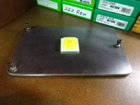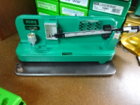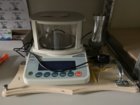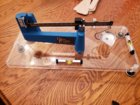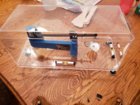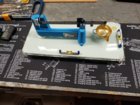Hey guys,
My beam scale is a Dillon Eliminator, made by Ohaus. It's been a great scale to date, but I've just recently got some check weights that go all the way down to .15 grains, and things didnt look so great last night. Everything was weighing about .2 grains heavier than the stated weight on the check weights.
After futzing around with it and trying to stave off another GAS attack to buy another scale, I figured out that my bench is not completely level. After placing the scale on a 14" long 1x4 hardwood board, and leveling that, it seems to read correctly now.
I'm trying to devise a way to have a "platform" that I can set the scale on that will give me a level area. I've seen alot of people use a sheet of tempered glass, which looks great in theory but if I put the glass on an unlevel bench to begin with, it wont help.
I'm thinking of building a small platform, say 6" wide by 12" long, and installing leveling feet on the bottom of it, along with a bubble level on all sides of the platform. The leveling feet are the kind that you can turn to adjust the height. That way I can ensure that my scale is level at all times. This would also be large enough to set my trickler on to trickle into the pan directly.
Has anyone done something like this, or know if something already exists? Maybe a self-leveling board of some sort?
LC
My beam scale is a Dillon Eliminator, made by Ohaus. It's been a great scale to date, but I've just recently got some check weights that go all the way down to .15 grains, and things didnt look so great last night. Everything was weighing about .2 grains heavier than the stated weight on the check weights.
After futzing around with it and trying to stave off another GAS attack to buy another scale, I figured out that my bench is not completely level. After placing the scale on a 14" long 1x4 hardwood board, and leveling that, it seems to read correctly now.
I'm trying to devise a way to have a "platform" that I can set the scale on that will give me a level area. I've seen alot of people use a sheet of tempered glass, which looks great in theory but if I put the glass on an unlevel bench to begin with, it wont help.
I'm thinking of building a small platform, say 6" wide by 12" long, and installing leveling feet on the bottom of it, along with a bubble level on all sides of the platform. The leveling feet are the kind that you can turn to adjust the height. That way I can ensure that my scale is level at all times. This would also be large enough to set my trickler on to trickle into the pan directly.
Has anyone done something like this, or know if something already exists? Maybe a self-leveling board of some sort?
LC












